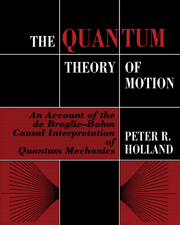 The Quantum Theory of Motion
The Quantum Theory of Motion Book contents
- Frontmatter
- Contents
- Preface
- 1 Quantum mechanics and its interpretation
- 2 Hamilton–Jacobi theory
- 3 Elements of the quantum theory of motion
- 4 Simple applications
- 5 Interference and tunnelling
- 6 The classical limit
- 7 Many-body systems
- 8 Theory of experiments
- 9 Spin ½: the Pauli theory
- 10 Spin ½: the rigid rotator
- 11 The Einstein–Podolsky–Rosen experiment and nonlocality
- 12 Relativistic quantum theory
- References
- Index
9 - Spin ½: the Pauli theory
Published online by Cambridge University Press: 20 January 2010
- Frontmatter
- Contents
- Preface
- 1 Quantum mechanics and its interpretation
- 2 Hamilton–Jacobi theory
- 3 Elements of the quantum theory of motion
- 4 Simple applications
- 5 Interference and tunnelling
- 6 The classical limit
- 7 Many-body systems
- 8 Theory of experiments
- 9 Spin ½: the Pauli theory
- 10 Spin ½: the rigid rotator
- 11 The Einstein–Podolsky–Rosen experiment and nonlocality
- 12 Relativistic quantum theory
- References
- Index
Summary
Introduction
The claim that it is impossible to construct a realistic physical model of quantum matter is often presented as definitively and finally proved in the case of systems with spin ½, or internal angular momentum of magnitude ħ/2, which exhibit a characteristic ‘nonclassical two-valuedness’. Nevertheless, the extension of the causal interpretation to embrace nonrelativistic spin ½ systems was successfully carried through in the 1950s (Bohm, Schiller & Tiomno, 1955; Bohm & Schiller, 1955; Takabayasi, 1955; Takabayasi & Vigier, 1957) and developed more recently (Dewdney, Holland & Kyprianidis, 1986, 1987a, b; Dewdney, Holland, Kyprianidis & Vigier, 1988). The idea is to assume that the spinor wave represents a new type of physical field propagating in spacetime that exerts an influence on a corpuscle moving within it. The additional information conveyed by the spinor beyond that contained in the spinless Schrödinger wave implies that the state of the particle is not exhausted by specifying its position and momentum, but that it is endowed with further properties such as an internal angular momentum.
The equation governing the dynamics of the spinor wavefunction is the Pauli equation:
where the Hamiltonian operator is given by
Here e, m and μ are respectively the charge, mass and magnetic moment of the particle, A0 and A are the electromagnetic potentials, B = ∇ × A is the magnetic field, V is any other external scalar potential, and σ is a vector whose components are the 2 × 2 Pauli matrices. The Hamiltonian (9.1.2) istherefore a 2 × 2 matrix operator and the wavefunction ψ(x, t) has two complex components.
Information
- Type
- Chapter
- Information
- The Quantum Theory of MotionAn Account of the de Broglie-Bohm Causal Interpretation of Quantum Mechanics, pp. 379 - 423Publisher: Cambridge University PressPrint publication year: 1993